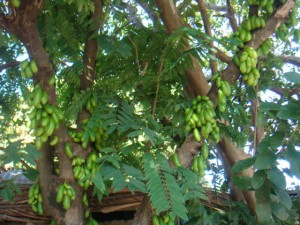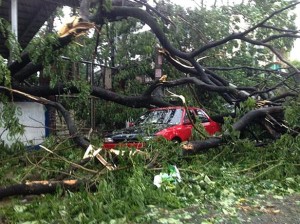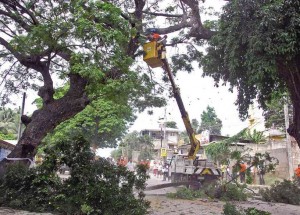Yes guys, I know this post is like a log in the dark.
The last time trees were being discussed in social media was months and months ago. That discussion didn’t go as viral as I thought it would, at least not in the way that other issues have.
Tree? What about them? Who cares?
| SUPPORT INDEPENDENT SOCIAL COMMENTARY! Subscribe to our Substack community GRP Insider to receive by email our in-depth free weekly newsletter. Opt into a paid subscription and you'll get premium insider briefs and insights from us. Subscribe to our Substack newsletter, GRP Insider! Learn more |
Right?! Right.
Thing is though, it isn’t just in its politics that you can see how dysfunctional Filipino society is, it’s something that is also pretty evident with how Filipinos regard trees (rivers, lakes, bays, mountains, hills, caves… really… pretty much anything in their environment).
Thing is, I didn’t figure myself for a tree lover until I had bought a house with a pretty huge yard filled with trees.
It’s not Hacienda Binay or Hacienda Luisita, but I’ve managed to buy my own piece of land in Marikina and with the land came a bunch of fruit trees – much to my delight.
There’s a pico mango tree, a rambutan tree, a suha tree, and a couple of other trees which a relative of my wife tells me are either lychee or longgam.
Tree wise, I tend to think that I’ve hit a jackpot because when I was still living in Sampaloc, Manila, the only trees we had were two kamias trees. Then after those trees died, my older brother planted fishtail palms much to the consternation of our neighbours who had gotten used to just getting this ‘free’ souring ingredient for ‘sinigang sa kamias’ from our trees – whether they asked permission to get some or not.
That’s pretty much the way people in our neighbourhood tended to treat the fruit trees in front of our house or anyone’s house along our street. They tend to think that any fruit or flower that grows there is free for the picking because it’s right on the side of the road which apparently is reason enough for them to believe that no one really owns it – despite the fact that it’s behind a fence – and therefore, can pick fruit from it at will.
My siblings and I didn’t mind much that people, some from barangays far away from ours, picked the kamias from our trees. After years and years of having kamias, we had grown tired of the fruit and when I was a kid, I used to mush up the fruit along with some leaves for the heck of it.
My mother, on the other hand, got pretty worked up if anybody in the neighbourhood so much as touched the tree. She’s been known to chase people off with a pretty big stick and let out a shout so shrill people thought there was a fire somewhere.
 She loved those trees, not for the fruit it bore, but simply because she had grown them from mere saplings. I can’t remember a day when she didn’t water those trees or a week when she didn’t dump fish guts around the base of the tree to fertilize the soil. When August came, she’d have people prune branches of the tree that seemed weak or parts of it that touched the house or went too far over the street. Every now and then, she’d check the trees for any kind of insect infestation and she’d have it sprayed if she found anything serious. She cared for those trees like they were part of the family.
She loved those trees, not for the fruit it bore, but simply because she had grown them from mere saplings. I can’t remember a day when she didn’t water those trees or a week when she didn’t dump fish guts around the base of the tree to fertilize the soil. When August came, she’d have people prune branches of the tree that seemed weak or parts of it that touched the house or went too far over the street. Every now and then, she’d check the trees for any kind of insect infestation and she’d have it sprayed if she found anything serious. She cared for those trees like they were part of the family.
They provided not just fruit, but also shade during the hot summer months and it shielded the house from the dust storms as well as clouds of diesel exhaust made by vehicles passing through our street.
It’s no wonder a lot of Manila’s wider streets used to be lined with trees.
One street in particular that even had pine trees was the one that used to be called Governor Forbes (now called Lacson Avenue) and it seemed they had been there for ages.
Most of those pine trees are gone now and the reason for their disappearance was, basically, neglect.
 As a kid, looking at those tall pine trees on Governor Forbes (pronounced as por-bes to distinguish it from the swanky Forbes Park residential area), I always wondered about how they actually managed to survive despite being overwhelmed with traffic smoke and soot every single day.
As a kid, looking at those tall pine trees on Governor Forbes (pronounced as por-bes to distinguish it from the swanky Forbes Park residential area), I always wondered about how they actually managed to survive despite being overwhelmed with traffic smoke and soot every single day.
But surviving the onslaught of daily air pollution is one thing, another thing these trees had to survive every year was the typhoon season. From the time I was in grade school, it wasn’t unusual for me to see a couple of trees on Governor Forbes that were felled by the strong winds of a recent typhoon. It usually caused heavy traffic for a day or two, until it got removed.
Then, there was this one day when a pretty huge branch from one of the pine trees just fell on a passing jeep and nearly totalled it. It was a good thing the tree branch fell on the jeep’s hood rather than the passenger section, otherwise it would have certainly killed someone.
Apparently, the tree had been infested with insects and after one of the tree’s branches fell, the rest of the tree died. It was reduced to a stump and it remained that way for years, I think, before someone got around to removing the stump to replace it with another tree.
 Recently, Typhoon Glenda’s rampage through the country a couple of huge trees that once towered over streets in Metro Manila.
Recently, Typhoon Glenda’s rampage through the country a couple of huge trees that once towered over streets in Metro Manila.
A couple of months ago, there was a big brouhaha over trees being cut to make way for road expansion projects in a couple of provinces south of Metro Manila. It seemed to me that some of the uproar (if it could be called that) was misplaced because in some areas, the trees posed as serious road hazards hazards such as cutting down daylight visibility because of the overgrown canopy, obstructing views because the trunks of the trees had considerable girth, and because of poor maintenance, branches would fall on passing vehicles every so often.
 The hazards posed by the trees, of course, were secondary to the need to expand roads that are part of the national highway. Some of the roads where the tree clearing was done were actually just two lane and four lane roads where traffic would sometimes be so slow that vehicles ended up crawling instead of zipping past it. This slow traffic tended to create a lot more air pollution because the vehicles engines weren’t operating at a higher efficiency, which could only be reached if they were travelling at a certain speed – upwards of 50 kph.
The hazards posed by the trees, of course, were secondary to the need to expand roads that are part of the national highway. Some of the roads where the tree clearing was done were actually just two lane and four lane roads where traffic would sometimes be so slow that vehicles ended up crawling instead of zipping past it. This slow traffic tended to create a lot more air pollution because the vehicles engines weren’t operating at a higher efficiency, which could only be reached if they were travelling at a certain speed – upwards of 50 kph.
I think, for the most part, people tend to treat trees in urban areas as they would treat trees growing in the forest – which is another way of saying that they don’t really do much to care for them. The only interaction they have with trees is when they either use them or abuse them.
And then some… Of late, this tree loving ethos has been exploited by sponsored pseudo-environmentalists who may have no idea of where trees provide the greatest benefit for a greater number of people. That’s an area called a ‘watershed’.
(More in Part Two of this Post)

Writer.

The country needs all the trees it can get, and yet the logging going on in northern Minadanao is destroying the environments ability to prevent vast flooding. BUT NO WORRIES, the drowning of the peasants is necessary to keep the nations elites from not having EVERYTHING !
Exactly. Trees are seen as obstacles. For example, a houseowner wanting to develop his property into several townhouses, then monetizing the space by either selling or having rented these spaces, will have to cut down the trees in the lot (though I admit my family did this too). The more you try to pack people into a small space, the more you’ll destroy a lot of things just to make them fit.
Chino, the purpose of trees inside cities is more for aesthetics really. If not maintained properly, as most trees are, they can really cause a lot of damage.
I was lucky that half of my mango tree didn’t crash on my house during Typhoon Glenda. I already had it pruned, but I guess I should have had it pruned even more or had its branches checked more thoroughly for any weaknesses.
Most time, people just let trees grow until they reach powerlines or its roots start destroying the pavement (which costs a lot to repair).
I wonder about that — wouldn’t there be a benefit in living in a moderately wooded enclave (in terms of cooler indoor temperatures leading to lower electrical consumption, etc.) as opposed to living in an area devoid of towering greenery, ringed to the hilt with stone and steel? I think I’m grasping at straws here, but there might be more on urban tree-planting at any rate than meets the eye.
Trees in urban areas are valued more for aesthetics.
Whether, you are an avid environmentalist or just a tree lover: trees absorb Carbon Dioxide in the atmosphere; and turn them into Oxygen…
We encourage people to plant trees and protect our forests…